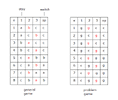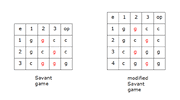forum;
Game rules.
1. Host cannot open player's 1st choice door.
2. host cannot open a door containing a car.
Prizes a, b, c, can be distributed 6 possible ways.
The general game is a sequence of
1. player chooses door1.
2. host opens door2 or door3 revealing no car, eliminating it from play.
3. player chooses door1 or door op.
For the problem game,
a and b are replaced with a generic g for goats

For the general game, the host has 2 possible choices for games e1 to e8.
door 1, 4c, 4g
door op, 4c, 4g
There is no advantage to switch.
For the problem game, the host has 2 possible choices for games e1 to e8.
door 1 is, 4c, 4g
door op is, 4c, 4g
There is no advantage to switch.

For Savant game, the host has 1 possible choice for games e1 and e2, and
2 possible choices for game e3.
door 1 is 2c, 2g
door op is 2c, 2g
There is no advantage to switch.
There is a problem with game e3. The host cannot open door2 and door3 in the same game, nor use alternate choices, which would be a different definition of a game.
Savant correctly identifies it, but does nothing to fix it.
"So let’s look at it again, remembering that the original answer defines certain conditions, the most significant of which is that the host always opens a losing door on purpose. (There’s no way he can always open a losing door by chance!)"
If e1 and e2 are played 10 times, and e3 is played 5 times revealing door2 and 5 times revealing door3, the data becomes biased.
door 1 is 10c, 20g
door op is 20c, 10g
There is an advantage to switch, but it is a fictitious one.
The fix is adding e4. The host can now open door2 or door3, and it's not a random choice.
For the modified Savant game, the host has 1 possible choice for games e1 to e4.
door1 is 2c, 2g
door op is 2c, 2g
There is no advantage to switch.
No surprise since it is half of the problem game.
The results depend on number of host choices which depends on the game rules.
The player who never knows the location of the car, can only make a random guess.
The game gives the appearance of player involvement.
Game rules.
1. Host cannot open player's 1st choice door.
2. host cannot open a door containing a car.
Prizes a, b, c, can be distributed 6 possible ways.
The general game is a sequence of
1. player chooses door1.
2. host opens door2 or door3 revealing no car, eliminating it from play.
3. player chooses door1 or door op.
For the problem game,
a and b are replaced with a generic g for goats

For the general game, the host has 2 possible choices for games e1 to e8.
door 1, 4c, 4g
door op, 4c, 4g
There is no advantage to switch.
For the problem game, the host has 2 possible choices for games e1 to e8.
door 1 is, 4c, 4g
door op is, 4c, 4g
There is no advantage to switch.

For Savant game, the host has 1 possible choice for games e1 and e2, and
2 possible choices for game e3.
door 1 is 2c, 2g
door op is 2c, 2g
There is no advantage to switch.
There is a problem with game e3. The host cannot open door2 and door3 in the same game, nor use alternate choices, which would be a different definition of a game.
Savant correctly identifies it, but does nothing to fix it.
"So let’s look at it again, remembering that the original answer defines certain conditions, the most significant of which is that the host always opens a losing door on purpose. (There’s no way he can always open a losing door by chance!)"
If e1 and e2 are played 10 times, and e3 is played 5 times revealing door2 and 5 times revealing door3, the data becomes biased.
door 1 is 10c, 20g
door op is 20c, 10g
There is an advantage to switch, but it is a fictitious one.
The fix is adding e4. The host can now open door2 or door3, and it's not a random choice.
For the modified Savant game, the host has 1 possible choice for games e1 to e4.
door1 is 2c, 2g
door op is 2c, 2g
There is no advantage to switch.
No surprise since it is half of the problem game.
The results depend on number of host choices which depends on the game rules.
The player who never knows the location of the car, can only make a random guess.
The game gives the appearance of player involvement.




